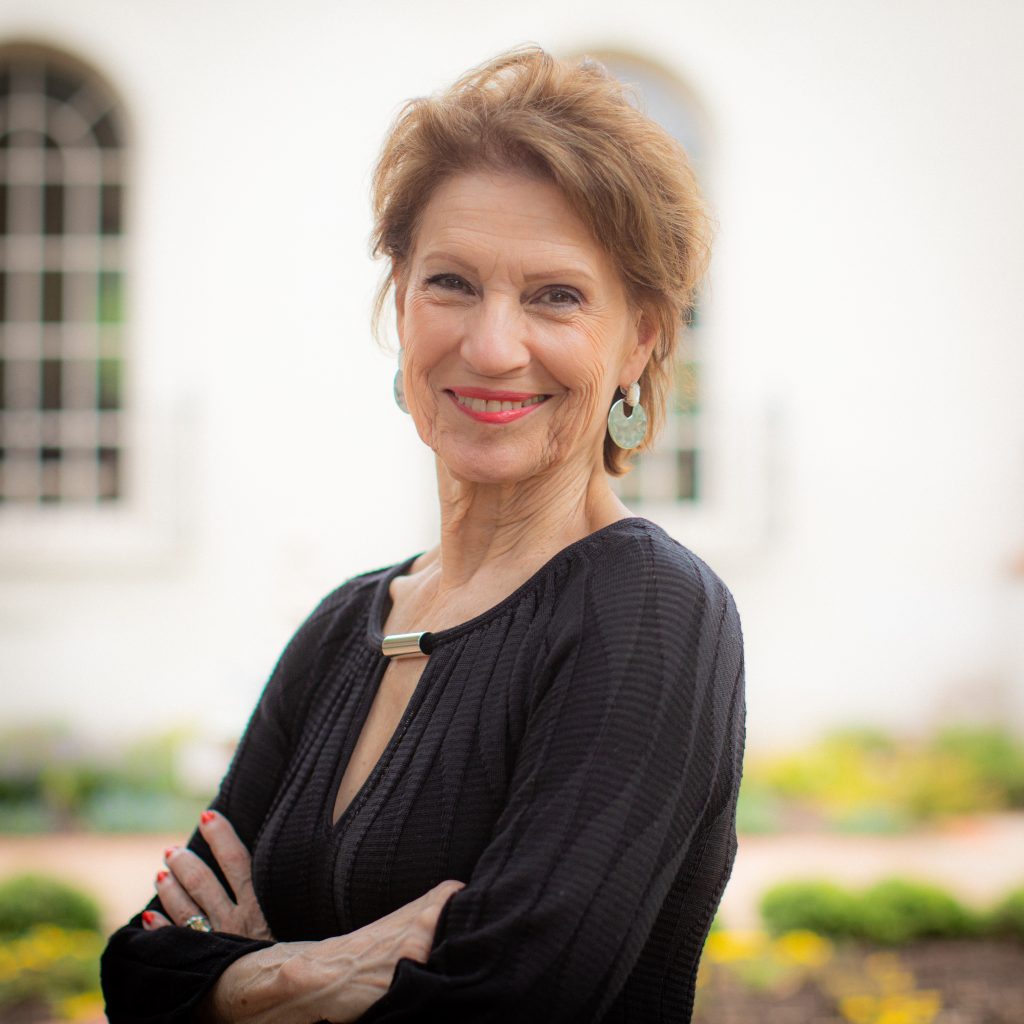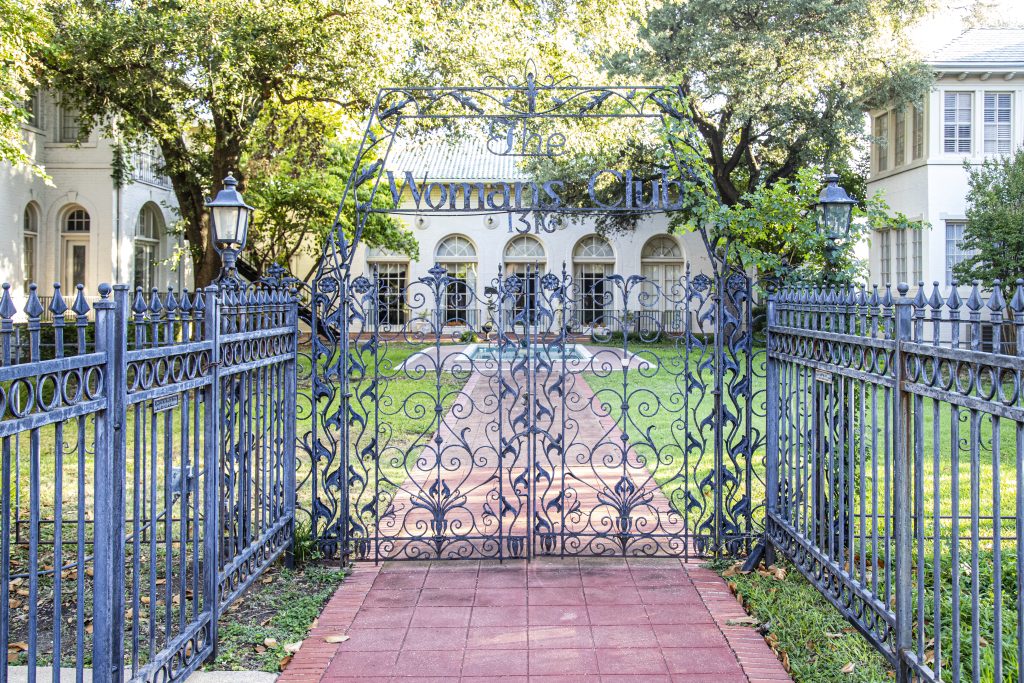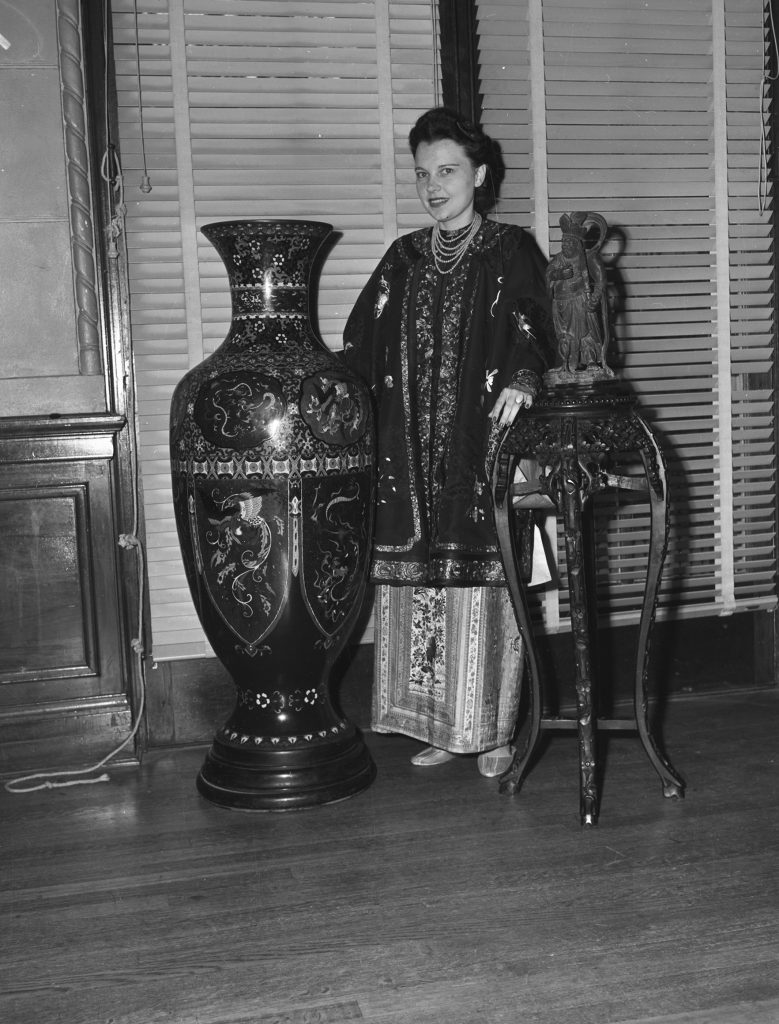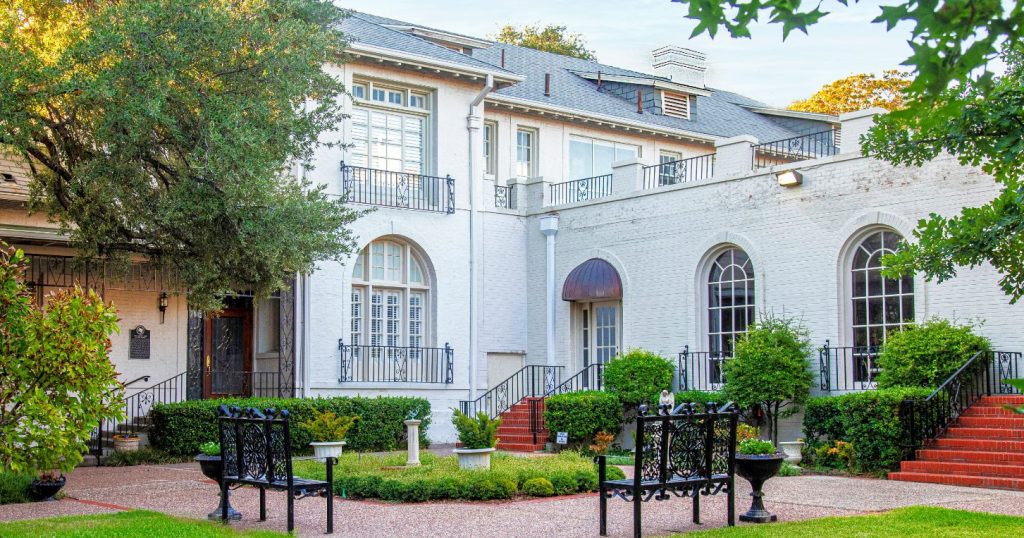Not Your Mama’s Woman’s Club: The Woman’s Club of Fort Worth Celebrates 100 Years
But its [The Club’s] most valuable asset was the very remarkable spirit of its membership which had been manifest throughout its existence, and which had seen it through every crisis that had arisen, including a worldwide depression.
~ The Woman’s Club of Fort Worth, The First 25 Years, 1923-1948
by Elizabeth Miller

One of the most highly anticipated events in the Fort Worth year is Concerts in the Garden. Who doesn’t love listening to the Fort Worth Symphony Orchestra (FWSO) play selections from Star Wars or classics by Queen or Led Zeppelin while picnicking with family and friends in our beautiful Botanic Garden? It’s a yearly tradition that is beloved by so many in our city, but it was almost lost before it began.
During the Great Depression, the Fort Worth Symphony Orchestra, like many civic and artistic organizations across the country, teetered on the verge of bankruptcy. In 1931, Mr. O.K. Shannon, honorary president of the FWSO, appealed to the community for help. And who stepped in to save the Symphony? The Woman’s Club of Fort Worth. (Remember this. It’s important.)
2023 marks the centennial of The Woman’s Club of Fort Worth (TWCFW). While the idea of clubs for women dates back to the 19th century, rest assured that this is not your mother’s Woman’s Club.
The woman’s club movement started in America in the early 1800s. Many grew out of church social circles. Intelligent women wanted to find a way to improve their minds and participate in social opportunities outside the home. These clubs allowed women to share their ideas as equals, and members realized that they could effect change in their communities. Many clubs were instrumental in leading the fight against slavery and for women’s suffrage. During the Progressive Era at the turn of the last century, these clubs championed literacy, denounced lynching, and led efforts to conserve public lands.
As the 20th century progressed, membership in woman’s clubs declined. More and more women were going into the workforce, and woman’s clubs were seen as relics of a bygone era. After spending an afternoon at TWCFW, I can tell you that there is nothing antiquated about it.

Jody Smith, President of The Woman’s Club of Fort Worth
photo credit: Brad Frace
I recently sat down with Club President Jody Kneer Smith and Sunnae Hiler, Executive Director of TWCFW, in the beautiful William G. Newby Memorial Building located on Pennsylvania Avenue. The campus consists of four historic, triple-landmarked buildings on a 2.2-acre campus right in the heart of the Hospital District. The campus, surrounded by a lovely wrought iron fence, is full of beautiful, mature trees and gardens. It is cool and green and inviting, even in the hottest months of the year.
Jody Smith has been a member of The Woman’s Club for 53 years. “I started in the Junior Woman’s Club (JWC) when I didn’t know anyone in Fort Worth. I didn’t grow up here. I didn’t go to college here… the relationships I formed have lasted from the JWC to the present. I see these women every time they come in for a meeting or lecture or luncheon.”
“I wanted a sisterhood,” Jody continued. “But I also wanted to learn something when I came. We study history, Shakespeare… we have art classes, we play mahjong… we learn something every time we come.”
In the early years of the last century, Fort Worth businesswoman and civic leader Anna Shelton spearheaded an effort to unite local woman’s clubs under one umbrella organization in one central location. In 1923, 11 charter clubs formed The Woman’s Club of Fort Worth. The club first met at the First Christian Church on Throckmorton until Etta Newby donated a house on Pennsylvania Avenue in the Quality Hill neighborhood to the Woman’s Club in memory of her late husband.

photo credit: Portraits by Polly
In 1931, The Woman’s Club stepped in and took over management of the Fort Worth Symphony Orchestra. (Remember what I said?) The Club continued to manage the FWSO until 1938, when the organization was back on its feet. During the Depression, the Club helped to keep local businesses open with their “manufacturer’s luncheons.” The Club also supported the Fort Worth Public Library, what eventually became Cook Children’s Medical Center, and other local organizations. Members of The Woman’s Club were instrumental in having street signs placed in Fort Worth. This year, the Club has raised funds and goods for She Supply and for the Naval Air Station Joint Reserve Base Pantry.
These are not little old ladies wearing white gloves, sipping tea from bone china teacups.
Sunnae said, “When I was young, my mom stayed home with me. Her career was taking care of her family, taking care of her home… And then we saw a gigantic shift when more and more women decided, ‘I want to be part of something bigger than being just a mom/wife/household manager.’ Membership dropped as more women entered the workforce.”

“Some of the household treasures to be seen at the antique show at the Woman’s Club. Mrs. Paul Baker is dressed in a Chinese costume as she stands next to some rare Chinese antiques. On the left is a large tall vase with intricate design and on the other side is a warrior figurine on an ornately carved stand (right).”
Fort Worth Star-Telegram Collection, University of Texas at Arlington Libraries. Woman’s Club antique show. (1941). Retrieved from https://library.uta.edu/digitalgallery/img/20038025
“But what we’re starting to see now,” Sunnae continued, “And it just fills my heart to the heaping top, is that women are wanting to belong to something again that’s not career oriented. They want to belong to a sisterhood and have a place where they can come and be surrounded by an incredibly diverse group of women… We have members who lived through the Great Depression. We have a member who is 105 years old and members who just turned 41.” [Membership is limited to women 41 and over. The Junior Woman’s Club, one of TWCFW’s daughter clubs, is open to women under the age of 40.]
The Club now has 38 clubs and 15 departments to appeal to almost everyone. What’s the difference between a club and a department, I hear you ask? Don’t worry, I asked the same question.
“The clubs are autonomous,” Jody said. “They come under the umbrella of TWCFW, but they operate independently. You do have to be a member of The Woman’s Club to be a member of a specialty club. The departments are open to any member of The Woman’s Club at any time. A club is usually restricted to 40 members, but a department is open to everyone.”
Some of the clubs under TWCFW’s umbrella include The Creative Arts Club, All About the Vine, The Junior Woman’s Club, Sorosis Club, History Club, and The Woman’s Shakespeare Club. The departments include the Art Department, Mahjong, Creative Writing, Yoga, and Needlework.
The Art Department runs an art studio on the campus. They offer classes and have studio times. “The Art Department also offers workshops for the public,” Sunnae said. “You’re allowed to take one without being a member of The Woman’s Club. If you want to take more than one workshop, you need to become a member, but then it’s unlimited. And they bring in nationally-known artists to teach [the workshops].”
Another department is called CHHiKs to Lunch, which according to Sunnae, is dedicated to trying new places to eat. “They literally sit around a table and eat and talk. How much more glorious could that be?”

photo credit: Portraits by Polly
The Junior Woman’s Club of Fort Worth is, as mentioned before, a club under the umbrella of The Woman’s Club. When a JWC member turns 41, she is invited to join TWCFW. Jody smiled, “We have a beautiful tradition called Crossing the Garden for those members. The new members leave the Margaret Meacham building and walk across the garden to our building… They are each given a flower by a current member and welcomed into the sisterhood.”
All members of TWCFW are automatically members of the Etta Newby Club and its extension, the Night Newbys. The Etta Newby Club presents programs with topics ranging from lectures on history to cooking demonstrations to opportunities to meet local and national authors. These presentations always include a luncheon. The Night Newbys also presents a diverse range of programs. While they don’t serve dinner, according to Sunnae, “they do serve heavy, delicious snacks.”
When I asked about the Club’s longevity, Sunnae was quick to point out that they are constantly adapting to fill their members’ needs. “We recognize that people are working, so we’re developing a Night Department for those who can’t come to events and meeting during the day… We recognized that a person who is new to town might not know two people to sponsor them [a requirement for club membership], so we changed it so that your employer can be your sponsor. We’re very open to changing as we need to while still keeping our traditions and preserving the respect that we have for our foremothers.”
The Club is on the web and on social media. There are separate Facebook and Instagram accounts for the Club and for the Club’s events and venue rentals. (The campus is a beautiful location for weddings, while the historic buildings are perfect for meetings and luncheons.) The Club is even on TikTok. If you want to take a virtual tour of the beautiful campus, check out the Club’s TikTok account.

photo credit: Portraits by Polly
Unfortunately, the Club’s historic buildings and campus are on Historic Fort Worth’s 2023 list of most endangered places in our city. They are the last remnants of what used to be called Silk Stocking Row. Sunnae said, “We’re really hopeful that someone will remember, ‘I had my recital in Anna Sheldon Hall.’ Or, ‘I used to have lunch with my grandmother in the tearoom.’ Or ‘I had my wedding reception in the garden.’ There are so many people who have a connection to the Woman’s Club. We’re hopeful that the Fort Worth community will remember what the Woman’s Club has done for our city, and maybe they’ll step in to help. We don’t expect it. We don’t demand it. But we hope.”
Every club needs new members to continue. I asked how a woman goes about becoming a member of The Woman’s Club. “A lot of our new members are people who have noticed us on the web and said, ‘I need a place to meet other women and make friends,’” Jody said. Sunnae said that there’s an inquiry form on the website, but Jody urged, “Come down to see us. We will give you a tour. We will tell you our history. We will help sponsor you. We will welcome you.”
Isn’t that what everyone wants? To be welcomed?
As we closed the interview, I was, as I tend to be, blunt. I asked, “What does The Woman’s Club of Fort Worth have to offer women in the 21st century?” Both Sunnae and Jody chuckled.

“National, state and local heads of the committees for the 1944 convention of the General Federation of Women’s Clubs, to be held in Fort Worth, left to right, Mrs. R. E. Cox, Miss Ethel Foster, Mrs. John N. Whitehurst and Mrs. J. W. Walker. The women are shown in dark formal wear with hats and mink stoles.”
Fort Worth Star-Telegram Collection, University of Texas at Arlington Libraries. Federation of Women’s Clubs. (1941). Retrieved from https://library.uta.edu/digitalgallery/img/20037980
Sunnae said, “Don’t assume that this is your mama’s Woman’s Club. We’re not a bunch of blue-haired old ladies. We’re women who have had amazing professional careers. The club is full of women who can mentor, who can guide, women who are willing to share their experiences in business and in life. What’s better than belonging to a sisterhood with women you may not have ever met if you didn’t join this organization?”
She continued, “We provide Fort Worth women with an opportunity to come to a place and be engaged in something that truly interests them and be surrounded by fascinating people. Who wouldn’t want to be a part of that? It’s belonging to something that is bigger than you, something that connects you to your community.”
Sunnae is right. There is a need in our lives for more than colleagues, neighbors, and family members. We may appreciate our colleagues, enjoy our neighbors, and love our family members, but forming friendships based on shared interests is incredibly important. “These are strong bonds we form in The Woman’s Club,” Jody said. “These are friends who will help you throughout your life.”
Sunnae nodded. “There are so many people in our city who have a connection with The Woman’s Club, whether it’s through recitals or weddings or visiting with a loved one in the tearoom. We want the community to know that we’re still here, and the buildings are still just as lovely. Come back home again.”



 Sign in
Sign in


A beautiful place, a beautiful history and a strong, intelligent goal that accommodates growth with planned flexibility. I look forward to experiencing you first hand next spring!
So well written and presented and I am pleased to be learning more. I hail from West Texas and have recently also bought a second home in Tarrant County. I am especially interested in mah jongg and so appreciate this opportunity to exchange contact information.